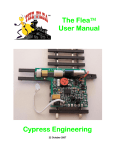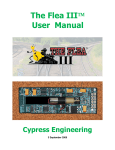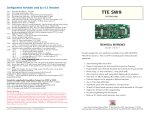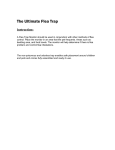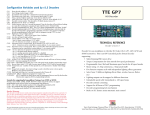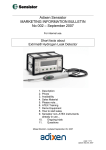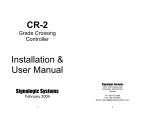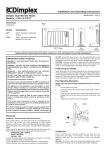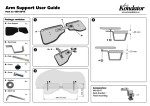Download Cypress Engineering The Flea II™ User Manual
Transcript
The Flea II User Manual Cypress Engineering 12 May 2008 1.0 Introduction Congratulations on your purchase of a Flea II switch machine actuator with integral DCC accessory decoder. This is a precision assembly that is factory installed on Walthers, Peco and Atlas® code 83 turnouts and can be factory installed on other HO switches supplied by the customer. The Flea II incorporates a miniature motor and gearbox that provides smooth, authentic motion during switch transitions. The Flea II comes in left hand and right hand versions for use with left hand and right hand turnouts. A major feature is the absence of under the layout wiring; all that is necessary is to hollow out a small cavity to accommodate the Flea in your layout. The integrated FLEA II / Code 83 Turnout is a precision mechanism. It should be handled accordingly. Avoid bending or flexing the turnout in any manner. It can cause open circuits in the DCC jumper straps and binding in the points. Larger models such as the double crossover, double slip and large radius curved switches should be held in the middle, never from one end. The motor drive mechanism must be kept free of dirt and debris. This is especially important during ballasting. The Flea II can be operated in DC or DCC layouts. When operated in a DC layout, it is powered from a DC power source that is independent of the track power source. In this mode the switch position is controlled by a toggle switch. When operated in a DCC layout, it can be powered from either the track or an independent power supply. In a DCC layout the switch position can be controlled from the DCC controller, a toggle switch or a combination of the DCC controller and a pushbutton. DO NOT REMOVE THE MOTOR CONNECTOR FROM THE SOCKET. THE SOCKET IS DESIGNED FOR A ONE TIME CONNECTION ONLY!" This manual is written for Version 2.4 of the Flea II software, see the Appendix for a list of changes since version 2.0. The software comes with two options: Option A is for right hand turnouts, it has a default address of 129 and is identified by a red sticker. Option B is for left hand turnouts, it has a default address of 128 and is identified by a blue sticker. The motor turns in opposite directions in the two options. There are no other differences between options A and B. NOTE: On double crossovers and the inner turnout on three way switches, the software is reversed. The red sticker is on the left hand turnouts and the blue sticker is on the right hand turnout. This is due to the way these switches are constructed. The default addresses remain the same for the color of the sticker. The red sticker has a default address of 129 and the blue sticker has a default address of 128. The Flea II has a pair of outputs intended to drive a dual LED indicator. These outputs can be used to drive an LED for a signal or control board indicator. A two lead, red/green LED is supplied for this purpose. It also has an on board LED to aid in initial programming. The LEDs indicate the turnout position; they also provide feedback during programming. One further function of the LEDs is to provide information about the Flea II immediately following power up. On power up the LED blinks out the address of the decoder, the operating mode and the software version. If an external LED is used, it will operate identically to the on board LED. The Flea II is capable of being programmed for route operations and can inter-operate with the Hare’s Smart Routes. 1.1 Addressing The decoder in the Flea II has its own address. This makes it possible for a DCC command station to send messages uniquely to it. The default address should be changed prior to installation in the layout. Otherwise more than one Flea II may respond to each command. After the address has been programmed the Flea II will permanently remember it until such time as it is changed again. The decoder address in the Flea II serves two purposes: Not only is it the accessory decoder address where switch Throw and Clear commands are sent but also it is the loco address where programming commands are sent. When choosing an address for the Flea II it is important that it be available both as an accessory decoder address and as a four digit loco address to avoid duplication of addresses. The Flea II does not respond to two digit loco addresses. The default addresses are 128 and 129 for the Option B and Option A software respectively. In situations where a turnout requires two Fleas II, that can only be powered simultaneously, (such as double slip switches and three way switches) one will have Option A software and the other will have Option B. This allows them to be individually addressed, and programmed to their own unique address. The Flea II may be programmed to any address in the range 128 to 2000 but check your command station and throttle to determine if the whole range is accommodated. It is important to keep a record of the decoder address for future use but if the address does become lost it may be read from the LEDs as part of the power up message. 2 CAUTION: Programming two switches to the same address MUST be avoided. The recovery process requires access to the solder pins on the circuit board or the removal of the switch from the layout. Keep a list of your switches with their addresses. A good idea would be to select a block of addresses for switches, large enough to cover all future needs, and use the next number in succession whenever a new switch is added to the layout. The LED blinks out the address of the switch on power up. This is a very helpful feature to avoid addressing conflicts. 1.2 Power Up Message Immediately following power up, the Flea sends a power up message to the Clear and Thrown LEDs. This provides information about the decoder address, the current mode, software version number and software option letter. First the decoder address is displayed as a series of pulses representing each digit. For example the default address of 128 is displayed as one pulse followed by two pulses followed by eight pulses. A single long pulse is used to represent a zero digit. If the Flea II is in Toggle Switch mode then the Clear LED is used for this part of the message. If the Flea II is in DCC mode or Dual mode the Thrown LED is used. Next the software version is displayed in similar fashion. For example version 2.3 is displayed as two pulses followed by three pulses. The Thrown LED is used for option A and the Clear LED is used for option B. QUICK START GUIDE Prior to installing the turnout in your layout do one of the following: If you will be operating in Toggle Switch mode all you have to do is hook up the toggle switch (Section 2.0). OR If you will be operating with DCC and/or a Pushbutton Switch the Flea must first be programmed (Section 7.0) Hint – see the Appendix for keystroke examples using Digitrax NCE and MRE. 1. Write down the current address of the Flea here __________ (Section 1.2) 2. Program CV63 at the current address to put the Flea in DCC mode or Dual mode (Section 7.4) 3. Choose a new address for the Flea and write it down here __________ (Section 1.1) 4. Program the new address into the Flea at the current address using CV16, CV17, CV18 (Section 7.1) 5. From now on you must use the new address, the Flea will no longer respond to the previous address. 6. If required, hook up a pushbutton switch (same connection as toggle switch) (Section 2.0) The turnout should now respond to pushbutton presses and/or to DCC Clear/Throw commands sent to the new address. Did the LED pulse after each CV was programmed? (Section 7.0) Did you use Ops Mode? (Section 7.0) Did you enter the current address as a 4 digit address? (Section 7.0) Did you choose a valid new address? (Section 1.1) 2.0 Operation by Toggle Switch Control The default mode for the Flea II is Toggle Switch control. If a toggle switch has been installed and the Flea II is in Toggle Switch mode then closing the switch will set the turnout into the Clear position and opening the switch will set the turnout into the Thrown position. It is important to note that the Flea II will still respond to DCC programming commands when in Toggle Switch mode. It is strongly recommended to change the address of the Flea II prior to installation in the layout, otherwise its operation may be modified any time programming commands are issued to the default address. 3 3.0 Operation by DCC Control When the Flea II has been changed to DCC mode it will respond to Accessory Decoder Clear and Throw commands issued to its decoder address. Authentic, prototypical operation is assured by the motor and gearbox actuator. The default mode for the Flea II is Toggle Switch mode. To change to DCC mode CV63 must be programmed (see section 7). It is recommended to program the decoder address prior to installation in the layout, the default addresses of 128 and 129 should not be used, as a final address, or unexpected results may arise due to inadvertent programming when the default address is used on a future occasion. See the Appendix for specific operating instructions for some of the popular command stations. 4.0 Dual Operation Using DCC and Pushbutton Control When the Flea II has been changed to Dual mode it will respond to Accessory Decoder Clear and Throw commands issued to its decoder address and also to a pushbutton. When the pushbutton is pressed the turnout will change to the alternate position and remain there until another command is received either from DCC or by another actuation of the pushbutton. The default mode for the Flea II is Toggle Switch mode. To change to Dual mode CV63 must be programmed (see section 7). A simple single pole, single throw (SPST) pushbutton is all that is required. It should have normally open contacts. The pushbutton is connected in the same way as a toggle switch, see Section 5.0 on how to do this. It is recommended to program the decoder address prior to installation in the layout, the default addresses of 128 and 129 should not be used or unexpected results may arise due to inadvertent programming when the default address is used on a future occasion. See the Appendix for specific operating instructions for some of the popular command stations. 5.0 Electrical Connections The following diagrams show the connections for the external LED, the toggle switch (if desired) and the separate power supply (if desired). NOTE: When using a separate power source, the voltage of this power source should always remain higher than the track voltage or the Flea II™ will draw power from the rails. The power source should be isolated from the rails. The wires should be carefully soldered to pads 1 and 3 using an iron with sufficient heat to quickly make the connection without damaging the board. For the toggle switch a simple single pole single throw (SPST) switch is all that is required and it does not matter which way round the connections are made. DO NOT REMOVE THE MOTOR CONNECTOR FROM THE SOCKET. THE SOCKET IS DESIGNED FOR A ONE TIME CONNECTION ONLY!" 4 6.0 Routes As well as the main decoder address it is possible to program up to 28 additional addresses that the Flea II will respond to for the purpose of routing. Unlike the decoder address that serves both as an accessory decoder address and as a loco address, the route addresses function only as accessory decoder addresses. Route addresses may range from 128 to 2000 but check your command station and throttle to determine if the whole range is accommodated. The default addresses of 128 and 129 should be avoided. By programming the same route address into a number of Flea IIs a single Clear or Throw command issued to the route address will cause each of the Flea IIs in the route to carry out the command. Each Flea IIs’ response to the command is determined by its action value for that particular route. 6.1 Route Action Values To facilitate desired route setting, each route in each Flea II may have its own action value, this determines what action to take in response to Clear and Throw commands sent to a route address. Action values have four possible settings as described in the following table. VALUE 0 1 2 3 6.2 RESPONSE TO A CLEAR COMMAND CLEAR THROWN THROWN CLEAR RESPONSE TO A THROW COMMAND THROWN CLEAR THROWN CLEAR Route Time Delay An additional feature of the Flea II, when being controlled as part of a route, is that each Flea II introduces a random time delay following a command before that command is carried out. This is to help avoid having all Flea II motors drawing current at the same time and placing a heavier burden on the power supply. The random time delay is between 0 and 10 seconds. 7.0 Programming Programming the Flea II involves setting the values of Configuration Variables (usually referred to as CVs). It is important to note that all programming of the Flea II is done to the four digit loco address in Ops mode. See the Appendix for specific operating instructions for some of the popular command stations. Each time a configuration variable accepts a programmed value the Clear and Thrown LEDs are pulsed to indicate success of the programming operation. 5 7.1 CV16 CV17 CV18 These three configuration variables are used to program the decoders’ address. The three CVs must be programmed in order as follows: a) Set CV16 to 0 b) Set CV17 to the upper two digits of the four digit decoder address c) Set CV18 to the lower two digits of the four digit decoder address For example, to program the address 0257 set CV16 = 0, CV17 = 02 (or just 2 will do), CV18 = 57. Any time a mistake is made simply start over with CV16. After the address has been changed, all subsequent programming must be directed to the new address. 7.2 CV49 There are two possible values for this configuration variable. Programming a value of 1 will cause the Flea II motor to turn in the opposite direction to normal in response to accessory decoder Clear and Throw commands. Programming a value of 0 will return the motor to normal operation. This configuration variable would be changed if the position of the turnout, in response to Clear and Throw commands, were the opposite of the desired position. 7.3 CV51 This configuration variable allows the power up position of the switch to be modified. The default value of 0 results in no action and the switch remains in its current position. Programming a value of 1 will cause the switch to assume the Clear position at power up. Programming a value of 2 will cause the switch to assume the Thrown position at power up. This CV has no effect in Toggle Switch mode. 7.4 CV63 There are three possible values for this configuration variable. Programming a value of 53 will change the Flea II to DCC mode. In this mode the toggle switch is ignored. Programming a value of 42 will return the Flea II to factory defaults and any prior programming will be lost. The factory default mode is Toggle Switch mode. The Clear and Thrown LEDs are pulsed four times to indicate the Flea II has been successfully returned to factory defaults. Programming a value of 31 will change the Flea II to Dual mode. In this mode the Flea II will respond to both DCC commands and pushbutton commands. 8.0 Route Programming The Flea II may be programmed with up to 28 route addresses and corresponding action values. The routes are numbered 1 through 28. Action values have a range of 0 – 3 and a default of zero. Any action value may be left unprogrammed if desired. 8.1 CV16 CV17 CV18 (Route Address Without Action Value) These three configuration variables are used to program a route address while leaving the action value unchanged. The three CVs must be programmed in order as follows: a) Set CV16 to the route number (1 – 28) b) Set CV17 to the upper two digits of the four digit route address c) Set CV18 to the lower two digits of the four digit route address For example, to program the address 0468 into route 9 set CV16 = 9, CV17 = 04 (or just 4 will do), CV18 = 68. Any time a mistake is made simply start over with CV16. 6 8.2 CV16 CV17 CV18 CV19 (Route Address With Action Value) These four configuration variables are used to program route addresses together with associated action values. The four CVs must be programmed in order as follows: a) Set CV16 to the route number (1 – 28) b) Set CV17 to the upper two digits of the four digit route address c) Set CV18 to the lower two digits of the four digit route address d) Set CV19 to the action value (0 – 3) For example to program the address 1234 into route 6 with an action value of 2 set CV16 = 6, CV17 = 12, CV18 = 34, CV19 = 2 Any time a mistake is made simply start over with CV16. 7 APPENDIX 1 – Digitrax DT400 Throttle Operation 1 Programming Configuration Variables (CVs) Press [EXIT][LOCO] Display shows something similar to this. Stat‘ 128’ SEL Lo0128 Use keypad to enter the address of the Flea to be controlled: [3][4][5] Stat‘ 128’ SEL Lo0345 Press [PROG] repeatedly until Po shows On the bottom line Ad2 = ??? CVNo Po0345 Using the left hand throttle set the number of the CV to be programmed: [63] 063 = ??? CVNo Po0345 Using the right hand throttle set the value for the CV to be programmed: [53] 063 = 053 CVNo Po0345 Press [ENTER] and observe the LEDs blink as the command is accepted 2 063 = 053 CVNo Po0345 Sending Clear and Throw Commands to the Flea SW SEL 128=t SwSEL Use keypad to enter the address of the Flea to be controlled: [3][4][5] SW SEL 345=t SwSEL Press [c] or [t] as desired: [c] The command is sent to the Flea SW SEL 345=c SwSEL Press [EXIT] [SWCH] Display shows something similar to this. 8 APPENDIX 2 – NCE Procab operation 1. Programming Configuration Variables (CVs) Press [PROG/ESC] Display shows something similar to this. SEL MODE 12:47PM PROGRAM ON THE MAIN Press [ENTER] Display shows something similar to this. OPS PROG 12:57PM PROG LOCO:_128 Use keypad to enter the address of the Flea to be controlled: [3][4][5] OPS PROG 12:57PM PROG LOCO:_345 Press [ENTER] Display shows something similar to this. OPS PROG 12:57PM 1=ADR 2=CV 3=CFG Press [2] Display shows something similar to this. PROG CV 12:57PM ENTER CV NUM: Use the keypad to set the number of the CV to be programmed: [6][3] PROG CV 12:57PM ENTER CV NUM:63 Press [ENTER] Display shows something similar to this. PROG CV 12:57PM ENTER VALUE: Use the keypad to set the value for the CV to be programmed: [5][3] PROG CV 12:57PM ENTER VALUE:53 Press [ENTER] and observe the LEDs Blink as the command is accepted PROG CV 12:57PM ENTER CV NUM: Press [PROG/ESC] to exit. 2. Sending Clear and Throw Commands to the Flea Press [SELECT ACCY] Display shows something similar to this. CONTROL 11:50 ACC NUMBER: 128 Use keypad to enter address of the Flea to be controlled: [3][4][5] Press [ENTER] ACC: 345 11:50 1=N(ON)2=R(OFF) Press [1] or [2] as desired: [1] (1= Clear and 2=Throw) The command is sent to the Flea ACC: 345 11:50 1=N(ON)2=R(OFF) 9 APPENDIX 3 – MRC Operation 1. Programming Configuration Variables (CVs) Press [PROG] twice. Display shows something similar to this. Prog Main Track Press [ENTER] Display shows something similar to this. Loco 0128 Main Track Use keypad to enter the address of the Flea to be controlled: [3][4][5] Loco _345 Main Track Repeatedly press [ENTER] until CV# shows on the upper line. CV# _ _ _ Main Track Using the keypad set the number of the CV to be programmed: [6][3] CV# _ 63 Main Track Press [ENTER] Display shows something similar to this. CV _ _ _ Data Main Track Using the keypad set the value for the CV to be programmed: [5][3] CV _ 53 Main Data Track Press [ENTER] and observe the LEDs blink as the command is accepted. CV _ 53 Main Data Track 2. Sending Clear and Throw Commands to the Flea Press [ACCY] Accy ___ Use the keypad to enter the address of the Flea to be controlled: [2] [4] [5] Address can only be between 128 and 255. Accy Press [ENTER] Display shows something similar to this. Accy 1or2 245 Press [1] or [2] as desired: [2] 1=Clear and 2=Throw The command is sent to the Flea Accy OFF 245 245 10 Appendix 4 – Software Revisions REVISION 2.0 2.1 2.2 2.3 2.4 CHANGES Initial release of this version Power up message added Dual mode added CV51 added Timing extended to accommodate Digitrax DCS100 11











